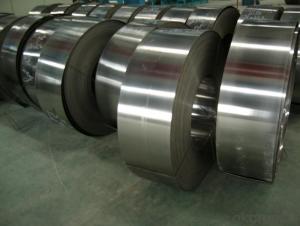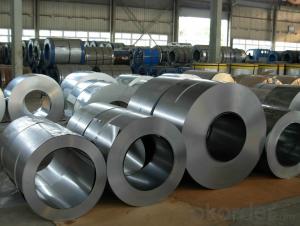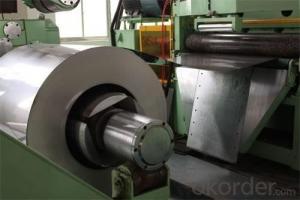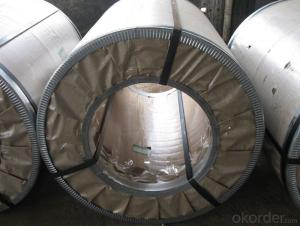Cold Rolled Steel Coil-High Strength Best Quality China
- Loading Port:
- China main port
- Payment Terms:
- TT OR LC
- Min Order Qty:
- 50 m.t.
- Supply Capability:
- 10000 m.t./month
OKorder Service Pledge
OKorder Financial Service
You Might Also Like
Cold Rolled Steel Coil-High Strength Best Quality China
1.Structure of Cold Rolled Steel Description:
The raw material of cold rolled steel coil/sheet is high quality hot rolled product, and after pickling continuous rolling, degreasing, annealing,skin pass,slitting and cut to length line etc. Along with it many kinds of new technology and new process of global cold rolling production have been applied. Therefore the quality of the goods could be guaranteed.
2.Main Features of Cold Rolled Steel Coil-High Strength Best Quality :
• Excellent process capability
• Smooth and flat surface
• Workability, durability
• High strength
• Good visual effect
3. Cold Rolled Steel Images:
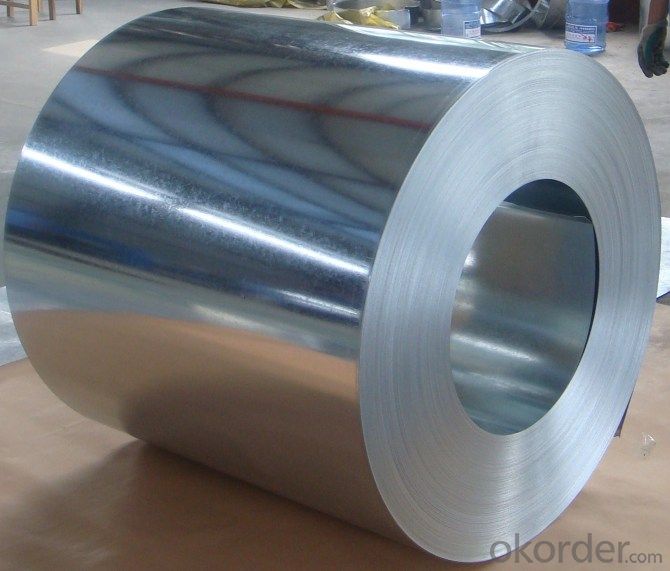
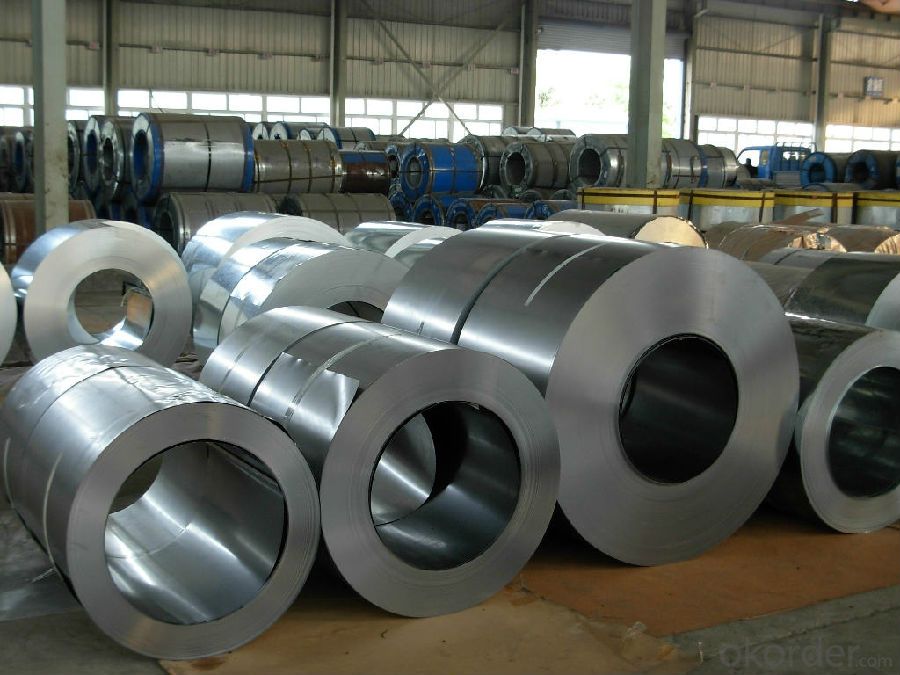
4.Cold Rolled Steel Specification
Standard:AISI,ASTM,DIN,GB,JIS,JIS G3302 ASTM 653M EN10142
Grade: Q195~Q345
Thickness: 0.16mm~2.0mm
Width: 1250mm MAX
Coil weight:3-12 MT
Coil ID:508/610mm
Chemical composition:
C | Si | Mn | Cr | Ni | P | S |
0.150 | 0.476 | 11.231 | 12.50 | 0.900 | 0.039 | 0.010
|
FAQ of Cold Rolled Steel Coil-High Strength Best Quality
1.How to guarantee the quality of the products?
We have established the international advanced quality management system,every link from raw material to final product we have strict quality test;We resolutely put an end to unqualified products flowing into the market.
2. How long can we receive the product after purchase?
Usually within thirty working days after receiving buyer’s advance payment or LC. We will arrange the factory manufacturing as soon as possible. The cargo readiness usually takes 15-25 days, but the shipment will depend on the vessel situation.
- Q:What are the dimensions of steel coils used in the metal furniture industry?
- Steel coils used in the metal furniture industry come in varying dimensions, depending on the specific requirements of each manufacturer. Commonly used dimensions include coil widths that range from 24 to 60 inches (61 to 152 cm) and coil diameters that range from 36 to 72 inches (91 to 183 cm). The thickness of the steel coils can also vary, typically falling between 0.020 and 0.250 inches (0.05 to 0.64 cm). These dimensions enable manufacturers to efficiently produce a variety of metal furniture, such as chairs, tables, and cabinets, by utilizing the steel coils as raw materials in their production processes.
- Q:What is the process of pickling and oiling steel coils?
- To ensure the quality and protection of steel coils, a series of steps are undertaken in the process of pickling and oiling. The first step involves pickling, wherein impurities and scale are removed from the surface of the steel coil. This is achieved by immersing the coil in an acid bath, such as hydrochloric acid or sulfuric acid, which effectively dissolves any oxides, rust, or contaminants present on the surface. This step is critical as it readies the steel for further processing and safeguards against potential defects or corrosion. Following pickling, the steel coils are rinsed with water to eliminate any residual acid and then dried. Once they are clean and dry, a layer of oil is applied to provide temporary corrosion protection and lubrication during subsequent handling and transport. The oil coating acts as a barrier, preventing rusting or oxidation before the steel undergoes further processing or is utilized in various applications. The oiling process can be executed through various methods. One common approach is to apply the oil using a roller or brush, ensuring an even coating across the entire surface of the coil. Alternatively, the coils can be passed through a bath or spray chamber where the oil is administered. The choice of oil depends on the specific requirements of the steel and its intended use, with options ranging from mineral oil and synthetic oils to specialized rust-preventive coatings. Once the oiling process is complete, the steel coils are typically stacked, wrapped, or packaged for storage or transportation. It is crucial to handle the coils with care to avoid damaging the oil coating and compromising the corrosion protection it provides. Overall, the pickling and oiling of steel coils are indispensable steps in the steel manufacturing process. They ensure the quality, cleanliness, and protection of the steel, thereby prolonging its lifespan and enhancing its performance in various applications.
- Q:Can steel coils be coated with luminescent materials?
- Yes, steel coils can be coated with luminescent materials.
- Q:How are steel coils inspected for width?
- To ensure compliance with the necessary specifications, various techniques are employed to inspect the width of steel coils. Among these methods, a commonly used one is the utilization of a caliper gauge, also referred to as a micrometer. This gauge makes direct contact with the coil edges to measure its width. The operator places the gauge at multiple points along the width and records the measurements. This approach guarantees precise measurements and facilitates the identification of any inconsistencies or deviations in the desired width. Another technique employed for width inspection is laser measurement. In this method, laser sensors are positioned on both sides of the coil, emitting a laser beam that scans across the width. By detecting the distance between the edges of the coil, the sensors provide accurate width measurements. This non-contact approach is highly efficient, swiftly inspecting the coil's width without causing any physical damage or requiring physical contact. Moreover, advanced systems employ computer vision technology for width inspection. This involves the use of cameras and image processing software to capture images of the coil's edges. The software then analyzes these images and calculates the width based on the detected edges. This method enables rapid inspections and can identify any irregularities in the coil's width. In conclusion, the inspection of steel coil width involves a combination of physical gauges, laser sensors, and computer vision technology. These methods ensure that the coils conform to the required width specifications and play a crucial role in maintaining quality control throughout the steel manufacturing process.
- Q:How are steel coils used in the manufacturing of power transmission towers?
- Steel coils are used in the manufacturing of power transmission towers as they are shaped and formed into the required structural components, such as beams and brackets. These coils are processed through rolling mills to obtain the desired thickness and shape, ensuring the strength and durability of the towers. The steel coils provide the necessary strength and structural integrity to support the weight of the transmission lines, withstand environmental conditions, and ensure reliable power transmission.
- Q:What are the major global steel coil markets?
- The primary concentration of major global steel coil markets lies in regions that possess significant industrial and manufacturing sectors. Key markets encompass North America, Europe, and Asia-Pacific. In North America, particularly the United States, the steel coil market holds substantial importance due to its large automotive industry and construction sector. The demand for steel coil in this region is propelled by the production of automobiles, infrastructure development, and residential construction. Europe stands as another crucial market for steel coil, with countries like Germany, Italy, and France acting as major consumers. The demand for steel coil in this region is driven by the automotive industry, construction sector, and machinery manufacturing. Asia-Pacific, specifically China, holds the position of the largest global market for steel coil. China's flourishing economy, rapid urbanization, and infrastructure development have resulted in a massive demand for steel coil. Alongside this, other countries in the region such as Japan, South Korea, and India also possess substantial steel coil markets due to their industrial and construction activities. Furthermore, emerging markets in Latin America, the Middle East, and Africa are witnessing a surge in demand for steel coil. These regions are experiencing economic growth and urbanization, leading to an increase in construction and infrastructure projects. In conclusion, the major global steel coil markets are propelled by industrial and manufacturing activities, infrastructure development, and construction projects in various regions across the globe.
- Q:Is the product of mild steel environmentally friendly? does it produce any emissions?The same question for leather aswell.
- Steel just rusts, it doesn't produce any emissions just sitting there. They even make architectural steel called Corten to rust to a nice patina. If you consider how the steel was made in the first place, a great big NO! Steel making requires massive amounts of electricity plus it gives off some nasty fumes in the liquid state. Leather itself doesn't emit much of anything, but the dyes might. Again though, if you look at how it's made, tanning leather is right up there with steel mills and paper mills for pollution, some of the worst.
- Q:What is the average shelf life of a painted steel coil?
- The average shelf life of a painted steel coil can vary depending on various factors such as the quality of the paint, environmental conditions, and storage methods. However, on average, a well-maintained painted steel coil can have a shelf life of 10 to 20 years.
- Q:What are the surface treatments for steel coils?
- There are several surface treatments available for steel coils, each serving a specific purpose and offering unique benefits. Some common surface treatments for steel coils include: 1. Hot-dip galvanizing: This process involves immersing the steel coil in a bath of molten zinc, resulting in a protective layer of zinc coating on the surface. Galvanizing provides excellent corrosion resistance, making the steel coil suitable for outdoor applications in harsh environments. 2. Electro-galvanizing: This method uses an electrolytic process to deposit a thin layer of zinc onto the steel coil's surface. Electro-galvanizing provides good corrosion resistance, but the coating is generally thinner compared to hot-dip galvanizing. 3. Pre-painting or pre-coating: Steel coils can be coated with paints or other coatings before being formed into final products. This surface treatment enhances the coil's aesthetic appeal while offering protection against corrosion, weathering, and other environmental factors. 4. Pickling and oiling: This surface treatment involves removing oxides and scale from the steel coil's surface by immersing it in an acid solution. After pickling, the coil is typically coated with oil to prevent rust formation during storage and transportation. 5. Phosphating: Phosphating is a chemical conversion coating process that forms a layer of phosphate on the steel coil's surface. This treatment improves the adhesion of subsequent coatings, such as paints or primers, while also providing some corrosion resistance. 6. Organic coatings: Steel coils can be coated with various organic materials, such as epoxy, polyester, or polyurethane, to enhance their corrosion resistance and aesthetic appearance. These coatings offer a wide range of colors, textures, and finishes, making them suitable for diverse applications. It is worth noting that the choice of surface treatment for steel coils depends on the intended application, environmental conditions, and desired appearance. Manufacturers and end-users must carefully consider these factors to select the most appropriate surface treatment for their specific needs.
- Q:How are steel coils used in the production of pressure vessels?
- Steel coils are used in the production of pressure vessels as they are rolled into cylindrical shapes, which serve as the main structural component of the vessel. The coils are formed and welded together to create a strong and durable container capable of withstanding high pressures.
1. Manufacturer Overview |
|
|---|---|
| Location | |
| Year Established | |
| Annual Output Value | |
| Main Markets | |
| Company Certifications | |
2. Manufacturer Certificates |
|
|---|---|
| a) Certification Name | |
| Range | |
| Reference | |
| Validity Period | |
3. Manufacturer Capability |
|
|---|---|
| a)Trade Capacity | |
| Nearest Port | |
| Export Percentage | |
| No.of Employees in Trade Department | |
| Language Spoken: | |
| b)Factory Information | |
| Factory Size: | |
| No. of Production Lines | |
| Contract Manufacturing | |
| Product Price Range | |
Send your message to us
Cold Rolled Steel Coil-High Strength Best Quality China
- Loading Port:
- China main port
- Payment Terms:
- TT OR LC
- Min Order Qty:
- 50 m.t.
- Supply Capability:
- 10000 m.t./month
OKorder Service Pledge
OKorder Financial Service
Similar products
New products
Hot products
Related keywords
